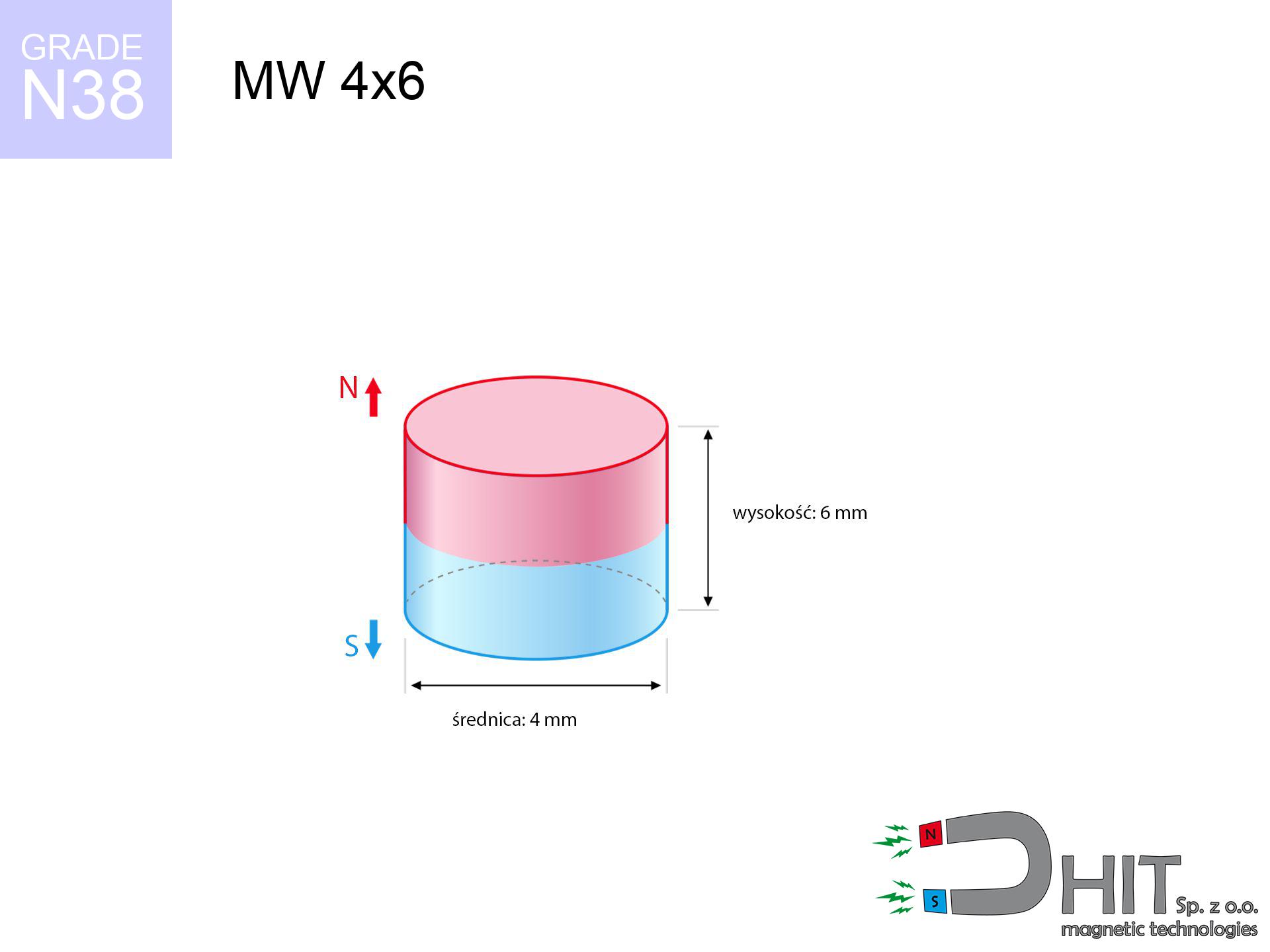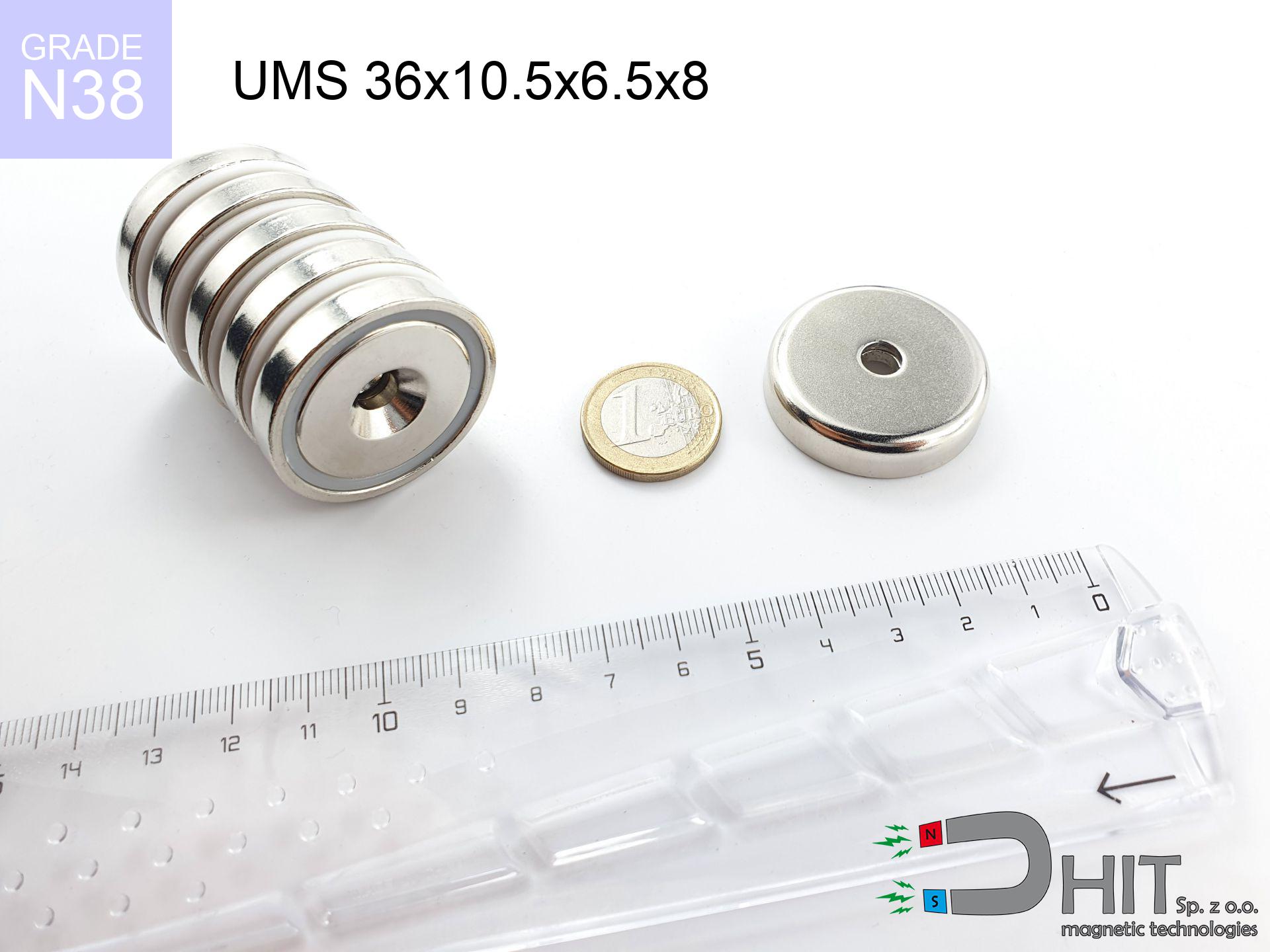MW 4x6 / N38 - cylindrical magnet
cylindrical magnet
Catalog no 010078
GTIN: 5906301810773
Diameter Ø
4 mm [±0,1 mm]
Height
6 mm [±0,1 mm]
Weight
0.57 g
Magnetization Direction
↑ axial
Load capacity
1.33 kg / 13.04 N
Magnetic Induction
586.32 mT
Coating
[NiCuNi] nickel
0.381 ZŁ with VAT / pcs + price for transport
0.310 ZŁ net + 23% VAT / pcs
bulk discounts:
Need more?Not sure about your choice?
Call us
+48 22 499 98 98
or drop us a message using
contact form
our website.
Parameters along with shape of magnets can be verified on our
our magnetic calculator.
Order by 14:00 and we’ll ship today!
Magnetic properties of material N38
Physical properties of sintered neodymium magnets Nd2Fe14B at 20°C
Shopping tips
Advantages and disadvantages of neodymium magnets.
In addition to their magnetic efficiency, neodymium magnets provide the following advantages:
- They have unchanged lifting capacity, and over more than 10 years their performance decreases symbolically – ~1% (in testing),
- Magnets effectively defend themselves against loss of magnetization caused by foreign field sources,
- The use of an aesthetic coating of noble metals (nickel, gold, silver) causes the element to be more visually attractive,
- Magnetic induction on the surface of the magnet remains strong,
- Due to their durability and thermal resistance, neodymium magnets can operate (depending on the shape) even at high temperatures reaching 230°C or more...
- In view of the option of free molding and customization to individualized needs, neodymium magnets can be manufactured in a wide range of geometric configurations, which expands the range of possible applications,
- Versatile presence in advanced technology sectors – they are utilized in data components, motor assemblies, precision medical tools, as well as technologically advanced constructions.
- Relatively small size with high pulling force – neodymium magnets offer strong magnetic field in compact dimensions, which allows their use in small systems
Disadvantages of NdFeB magnets:
- Brittleness is one of their disadvantages. Upon strong impact they can break. We recommend keeping them in a steel housing, which not only secures them against impacts but also raises their durability
- When exposed to high temperature, neodymium magnets suffer a drop in strength. Often, when the temperature exceeds 80°C, their strength decreases (depending on the size, as well as shape of the magnet). For those who need magnets for extreme conditions, we offer [AH] versions withstanding up to 230°C
- They oxidize in a humid environment - during use outdoors we recommend using waterproof magnets e.g. in rubber, plastic
- We recommend cover - magnetic mechanism, due to difficulties in creating nuts inside the magnet and complicated forms.
- Possible danger resulting from small fragments of magnets are risky, when accidentally swallowed, which gains importance in the context of child health protection. Additionally, tiny parts of these magnets can complicate diagnosis medical in case of swallowing.
- Due to expensive raw materials, their price is higher than average,
Detachment force of the magnet in optimal conditions – what contributes to it?
The declared magnet strength represents the peak performance, measured under ideal test conditions, namely:
- using a plate made of mild steel, acting as a magnetic yoke
- with a thickness minimum 10 mm
- characterized by smoothness
- with direct contact (without coatings)
- during detachment in a direction perpendicular to the plane
- at standard ambient temperature
Determinants of lifting force in real conditions
During everyday use, the actual lifting capacity is determined by a number of factors, presented from the most important:
- Distance (between the magnet and the metal), because even a very small distance (e.g. 0.5 mm) leads to a decrease in force by up to 50% (this also applies to paint, rust or dirt).
- Force direction – remember that the magnet has greatest strength perpendicularly. Under shear forces, the holding force drops significantly, often to levels of 20-30% of the maximum value.
- Element thickness – to utilize 100% power, the steel must be sufficiently thick. Thin sheet restricts the lifting capacity (the magnet "punches through" it).
- Plate material – mild steel gives the best results. Higher carbon content reduce magnetic permeability and lifting capacity.
- Surface condition – ground elements ensure maximum contact, which increases field saturation. Uneven metal reduce efficiency.
- Thermal conditions – neodymium magnets have a negative temperature coefficient. At higher temperatures they are weaker, and at low temperatures they can be stronger (up to a certain limit).
* Lifting capacity testing was conducted on a smooth plate of suitable thickness, under perpendicular forces, however under shearing force the lifting capacity is smaller. In addition, even a slight gap {between} the magnet’s surface and the plate reduces the load capacity.
Safe handling of neodymium magnets
Safe distance
Device Safety: Neodymium magnets can ruin payment cards and sensitive devices (heart implants, medical aids, mechanical watches).
Risk of cracking
NdFeB magnets are sintered ceramics, meaning they are prone to chipping. Impact of two magnets leads to them breaking into small pieces.
Demagnetization risk
Monitor thermal conditions. Exposing the magnet above 80 degrees Celsius will permanently weaken its properties and strength.
Adults only
Strictly store magnets out of reach of children. Ingestion danger is significant, and the effects of magnets connecting inside the body are tragic.
Allergic reactions
A percentage of the population experience a hypersensitivity to Ni, which is the typical protective layer for neodymium magnets. Frequent touching might lead to a rash. It is best to use safety gloves.
Impact on smartphones
An intense magnetic field disrupts the operation of compasses in phones and GPS navigation. Do not bring magnets near a smartphone to prevent breaking the sensors.
Crushing risk
Large magnets can smash fingers instantly. Never put your hand between two attracting surfaces.
Flammability
Powder generated during grinding of magnets is flammable. Do not drill into magnets without proper cooling and knowledge.
Handling rules
Before use, check safety instructions. Uncontrolled attraction can break the magnet or hurt your hand. Be predictive.
Medical interference
People with a heart stimulator should keep an safe separation from magnets. The magnetism can disrupt the operation of the life-saving device.
Security!
More info about hazards in the article: Safety of working with magnets.







![UMGGW 34x8 [M4] GW / N38 - magnetic holder rubber internal thread UMGGW 34x8 [M4] GW / N38 - magnetic holder rubber internal thread](https://cdn3.dhit.pl/graphics/products/umg-34x8-m4-gw-kek.jpg)

